| Description | Participants | Summaries | Products |
|---|
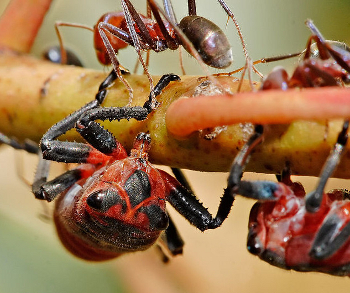
Archived NIMBioS Working Group:
Vector Movement and Disease
Topic: Causes and consequences of vector movement: Implications for the spread of plant pathogens
Meeting dates: Mar 30 - Apr 2, 2015; Oct 26-29, 2015; Mar 29-Apr 2, 2016; Jan 30-Feb 2, 2017
Organizers:
Allison Shaw, Ecology, Evolution and Behavior, Univ. of Minnesota
David Crowder, Entomology, Washington State Univ.
Jan Medlock, Biomedical Sciences, Oregon State Univ.
Objectives: Plant pathogens that are spread by arthropod vectors impact ecosystems around the world. Intuitively, the movement of vectors influences pathogen spread, as pathogens cannot spread if vectors do not move. However, we currently lack a comprehensive understanding, both empirically and theoretically, of the role that vector movement plays in the spread of plant pathogens. The goals of this working group are to (i) develop a general understanding of how vector movement is driven by vector population dynamics, characteristics of host plants and landscapes, and community dynamics, and (ii) investigate the implications of vector movement for the dispersal of vector-borne plant pathogens. The working group brings together expertise from the fields of mathematics, ecology, entomology, plant sciences, epidemiology, and animal movement. Our approach combines existing modeling techniques from the broader animal movement literature with mathematical models for vector-borne pathogen transmission. We will incorporate data from lab- and field-based empirical studies into models to determine how vector movement impacts the spread of disease within fields and across landscapes. We will also consider the relative importance of vector growth rates and movement behaviors and the role of virus persistence in the vectors on disease spread. Based on our findings, we will explore what potential control actions can be taken to more effectively manage plant diseases. The working-group format will ideally allow us to establish an array of new collaborations and result in publications in leading journals in a range of fields. Ideas for this working group benefited from discussions at the NIMBioS Investigative Workshop on Vector Transmission of Plant Viruses.
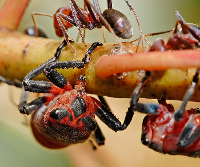
Meeting Summaries
| Mtg # | Dates | Agenda | Summary | Photo | Evaluation |
|---|---|---|---|---|---|
| 1 | Mar 30 - Apr 2, 2015 | Link | Link | Report | |
| 2 | Oct 26-29, 2015 | Link | Link | ||
| 3 | Mar 29-Apr 2, 2016 | Link | Link | ||
| 4 | Jan 30-Feb 2, 2017 | Link | Report |
Meeting 1 summary. The first meeting was attended by 14 of our 16 working group members. Discussion was stimulated by five short talks (four empirical and one modeling) throughout the meeting. We spent the first day of the meeting brainstorming longterm goals for the group and distilling these into concrete projects. We spent the remaining two and a half days of the meeting primarily in three breakout groups, which aimed to understand how vector borne plant pathogens are affected by (1) different transmission mechanisms, (2) different interspecific interactions, and (3) conditional vector life history and behavior. Each group formulated specific research questions and drafted an initial model. The initial motivating examples include viral diseases of cassava (the most important staple food crop in Africa) and Barley yellow dwarf virus (a crucial pathogen in cereal crops). Data-based modeling of these mechanisms, behaviors, and interactions will aid in disease management of several major food crops.
Meeting 2 summary. Our second meeting was attended by 14 of our 16 working group members. Discussion was stimulated by the groups introducing their models: Modeling differential transmission mechanisms in vector borne viral cassava diseases in Africa (Bosque-Pérez, Cintroni-Arias, Kuang, Lee, Legg, Lenhart, Lewis, Li), The impact of vector interaction with other insect species on disease spread (Borer, Crowder, Finke, Li, Medlock, Pattemore, Sharon), and The relative importance of vector life history and behavior in driving pathogen spread (Bosque-Pérez, Peace, Power, Shaw). We spent most of the first 2 days of the meeting working on these subjects. At the end of each day we met all together and brainstormed one each group's subject, distilling these into concrete projects and combining the skills of members of the whole group in order to improve the models and the implications and potential outcome of the models. We spent a few hours every day discussing new directions and emerging ideas. The last day was dedicated to formation of new groups and discussion of the next steps to be taken in the future.
Meeting 3 summary. Our third meeting was attended by 12 of our 16 working group members, and all other members participated remotely throughout the week. The first day was dedicated to brainstorming new directions and forming of new breakout groups. In the preceding days, we spent the first half of the day in existing breakout groups and the second half in the newbreakout groups. Existing breakout groups continued discussions and model developments, making significant progress on the following projects: "Modeling Differential Transmission Mechanisms in Vector-borne Viral Cassava Diseases in Africa" (Bosque-Pérez, Cintron-Arias, Kuang, Lee, Legg, Lenhart, Lewis, Li), "The Impact of Vector Interaction with Other Insect Species on Disease Spread" (Borer, Crowder, Finke, Li, Medlock, Pattemore, Sharon), and "The Relative Importance of Vector Life History and Behavior in Driving Pathogen Spread" (Bosque-Pérez, Peace, Power, Shaw).
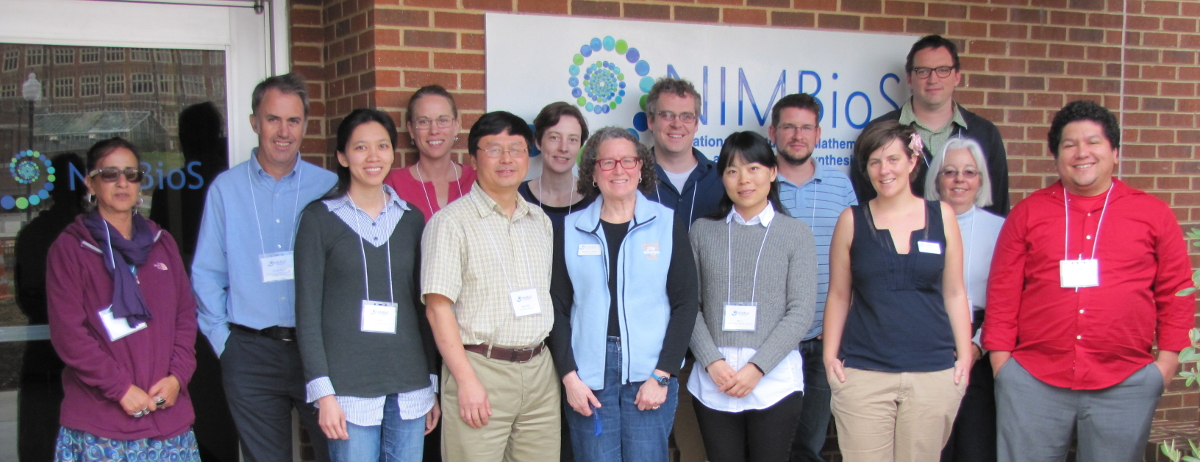 |
| Meeting 1 participants (L to R): Rakefet Sharon, James Legg, Jo Ann Lee, Deborah Finke, Yang Kuang, Allison Shaw, Suzanne Lenhart, David Crowder, Jing Li, David Pattemore, Angie Peace, Jan Medlock, Nilsa Bosque-Perez, Ariel Cintron-Arias |
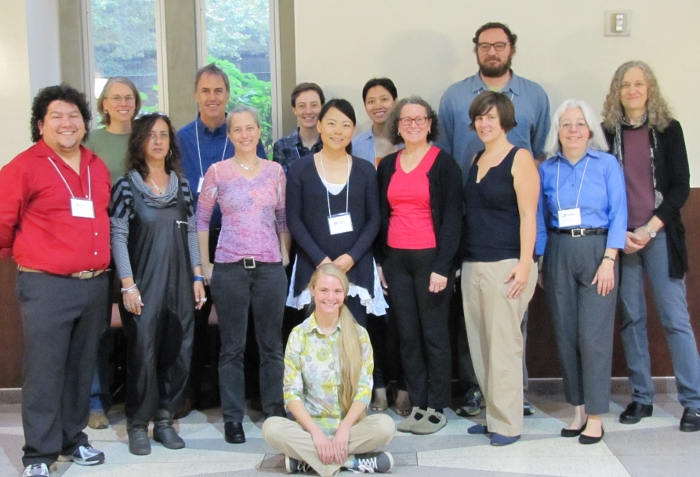 |
| Meeting 2 participants (L to R): Ariel Cintron-Arias, Deborah Finke, Rakefet Sharon, James Legg, Elizabeth Borer, Allison Shaw, Jing Li, Chelsea Lewis (seated), Jo Ann Lee, Suzanne Lenhart, Angie Peace, Jan Medlock, Nilsa Bosque-Perez, Alison Power. Not Pictured: Yang Kuang. |
 |
| Meeting 3 participants (L to R): Yang Kuang, David Crowder, Angie Peace, Suzanne Lenhart, Alison Power, Chelsea Lewis (kneeling), Nilsa Bosque-Perez, Jo Ann Lee, Jing Li, Allison Shaw, Ariel Cintron-Arias, Rakefet Sharon. |
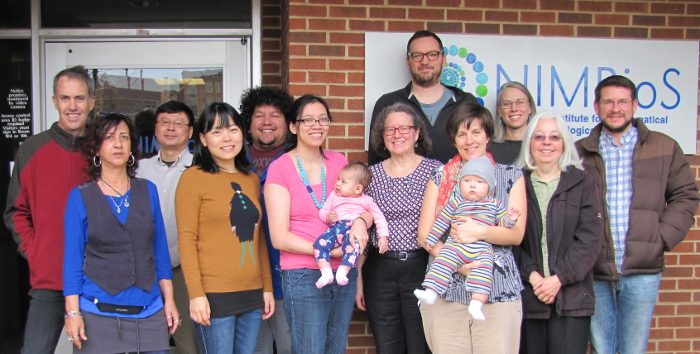 |
| Meeting 4 participants (L to R): James Legg, Rakefet Sharon, Yang Kuang, Jing Li, Ariel Cintron-Arias, Jo Ann Lee, Suzanne Lenhart, Jan Medlock, Angie Peace, Deborah Finke, Nilsa Bosque-Perez, David Pattemore. Not Pictured: David Crowder. |
NIMBioS Working Groups are chosen to focus on major scientific questions at the interface between biology and mathematics. NIMBioS is particularly interested in questions that integrate diverse fields, require synthesis at multiple scales, and/or make use of or require development of new mathematical/computational approaches. NIMBioS Working Groups are relatively small (up to 10 participants), focus on a well-defined topic, and have well-defined goals and metrics of success. Working Groups will meet up to 3 times over a two-year period, with each meeting lasting up to 2.5 days.
A goal of NIMBioS is to enhance the cadre of researchers capable of interdisciplinary efforts across mathematics and biology. As part of this goal, NIMBioS is committed to promoting diversity in all its activities. Diversity is considered in all its aspects, social and scientific, including gender, ethnicity, scientific field, career stage, geography and type of home institution. Questions regarding diversity issues should be directed to diversity@nimbios.org. You can read more about our Diversity Plan on our NIMBioS Policies web page. The NIMBioS building is fully handicapped accessible.
NIMBioS
1122 Volunteer Blvd., Suite 106
University of Tennessee
Knoxville,
TN 37996-3410
PH: (865) 974-9334
FAX: (865) 974-9461
Contact NIMBioS


